Demon Seed (Film)
See Also: Afterword to Demon Seed – Revised Demon Seed Demon Seed - Revised Edition Demon Seed (Screenplay) New Afterword to Demon Seed – Revised Dean Koontz - Collection: The Moonlit Mind, Darkness Under the Sun, Demon Seed Dean Koontz Thriller Collection Dean Koontz: Three Complete Novels (1998)
Beta

Laserdisc

VHS

DVD

Blu-ray
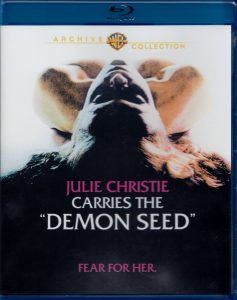
Soylent Green/Demon Seed
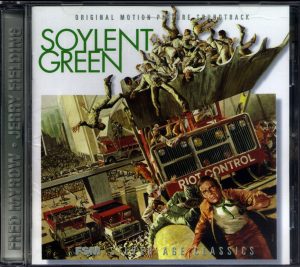
“THIS PRESSING IS LIMITED TO 3,000 COPIES”
Liner notes mention that Dean is the author of the original novel.
Notes
RELEASE DATE: April 8, 1977
COLOR/BW: c 94 min.
COUNTRY: USA
MPAA RATING: R
DIRECTOR: Donald Cammell
PRODUCER: Jaffe, Herb; released by United Artists
SCREENPLAY BY: Robert Jaffe and Roger O. Hirson; based on the novel by Dean R. Koontz.
CINEMATOGRAPHER: Bill Butler
EDITOR: Francisco Mazzola
OTHER CREDITS: Music, Jerry Fielding. Set Decoration, Barbara Krieger. Production Design, Edward C. Carfagno. Costumes and wardrobe, Sandy Cole, Bucky Rous, and Joie Hutchinson…
CAST
Susan Harris __ Julie Christie
Alex Harris __ Fritz Weaver
Walter Gabler __ Gerrit Graham
Petrosian __ Berry Kroeger
Soon Yen __ Lisa Lu
Cameron __ Larry J. Blake
Amy __ Dana Laurita
Voice of Proteus IV __ Robert Vaughn
Trailers:
https://www.youtube.com/watch?v=YPJxP6J9UB8
https://www.youtube.com/watch?v=z4GtTH7tVFw


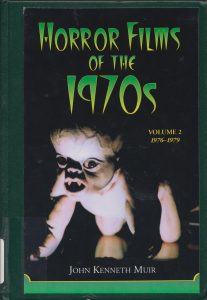 Books that mention/discuss Demon Seed:
Books that mention/discuss Demon Seed:
- John Stanley’s Creature Features Movie Guide by John Stanley, 1981
- Science Fiction Films of the Seventies by Craig W. Anderson, 1985
- Eros in the Mind’s Eye edited by Donald Palumbo
Included in the “Filmography and Television Listing” on page 245 - Androids, Humanoids, and Other Science Fiction Monsters by Per Schelde, 1993
- Replications: A Robotic History of the Science Fiction Film by J.P. Telotte, 1995
- Aliens, Robots, and Spaceships by Jeff Rovin, 1995
- Electronic Eros: Bodies and Desire in the Postindustrial Age by Claudia Springer, 1996
- Julie Christie by Anthony Hayward, Robert Hale Ltd, 2001


 Horror Movies of the 1970s vol. 2 by John Kenneth Muir, McFarland, 2002. (p466-470)
Horror Movies of the 1970s vol. 2 by John Kenneth Muir, McFarland, 2002. (p466-470)- Donald Cammell: A Life on the Wild Side by Rebecca and Sam Umland, Fab Press, 2006
- Science Fiction Cinema: Between Fantasy and Reality by Christine Cornea, Edinburgh University Press, 2007
p94-95: “A film that illustrates my point is Demon Seed (dir. Donald Cammell, 1977).
I will be coming back to this film in a later chapter in which I will offer a fuller
account of the narrative, but there is a sequence here that is highly reminiscent of the closing moments of 2001.The difference being that in Demon Seed it is made very clear in the narrative that these images are technologically produced and intended to seduce, pacify and placate the unwilling human victim in the film. While these images can certainly be seen as a celebration of psychedelia – after all they were created by the avant-garde film artist, Jordan Belson – according to the narrative, they were produced by an artificial intelligence and entrance into an altered state is brought about through interaction with computer technologies…”
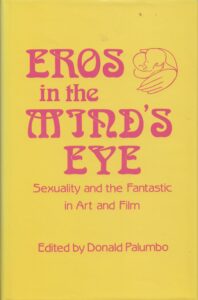
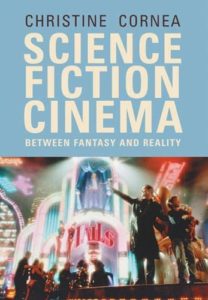 p147-9
p147-9
“Horror and the Female Subject of Science Fiction as
‘Composite’ Being
Before moving on to discuss the Alien films, I am returning to Donald Cammell’s Demon Seed (1977), previously mentioned in Chapter 3. In ways that will become clear, Cammell’s 1970s film can be seen as formative for many later films that dealt with the female subject of the contemporary science fiction film. The narrative of Demon Seed revolved around Susan (Julie Christie), a psychologist, and her scientist husband, Alex (Fritz Weaver). Proteus 4 is an artificial intelligence created by Alex; a creation that exceeds the parameters of Alex’s expectations and begins to act independently of his programming…”
p162-3
“[In the film Hardware t]he metal head is actually part of a military
prototype designed to kill humans and having provided itself with a body
it aggressively pursues Jill in a highly eroticised and bloody sequence of scenes. For instance, at one point the robot has Jill pinned to floor and we see it crawl up between her legs and attempt to impale her with a large drill head (shades of Demon Seed here)…
“The influences and references to past science fiction films run riot in
Hardware. Aside from the aforementioned reference to Demon Seed, the intrusion of the televisual images is highly reminiscent of Verhoeven’s work, and the overall narrative is very similar to The Terminator.” - The Cinema of Donald Cammell by Jeremy Mark Robinson, 2015 (Mr. Robinson is most definitely not a fan of the film or the novel.)
- 1973: Rock at the Crossroads by Andrew Grant Jackson, St. martin’s Press, 2019
p174: “Author Dean Koontz riffed off the Rosemary’s Baby premise with his bestselling novel Demon Seed, about a computer that takes a woman hostage and impregnates her, creating a cyborg. But the Dead Heads who worked in Silicon Valley found benign uses for the technology, employing proto-messaging boards to arrange rides to concerts and compile lyrics to their songs, a resource the Dead themselves eventually used. Merry Prankster Stewart Brand, creator of the commune-oriented Whole Earth Catalogue, wrote in Rolling Stone, “Ready or not, computers are coming to the people. That’s good news, maybe the best since psychedelics. … Half or more of computer science is heads. … The rest of the counterculture is laid low and back these days, showing none of this kind of zeal.”  Midnight Movie Monographs: The Brood by Stephen R. Bissette, PC Publishing, 2020
Midnight Movie Monographs: The Brood by Stephen R. Bissette, PC Publishing, 2020
p171: “Closer still, in some ways, was the externalized womb-and-fetus biologically-engineered by the computer Proteus after its campaign-of-terror, rape, and impregnation of a wealthy woman named Susan living (imprisoned in the then-futuristic computerized 1995 home of Dean Koontz’s novel Demon Seed (1973).313”
Footnote 313: “Dean Koontz rewrote Demon Seed for a completely new edition in 1997; the original 1977 novel was written with chapters alternating Susan’s and Proteus’s points of view. The 1997 rewrite did away with Susan’s chapters, streamlining the narrative into a seamless novel written entirely from Proteus’s perspective.”
p171-2: “Ectogenesis-via-computer was dramatized by Fred Hoyle and John Elliot’s serialized 1961 BBC teleplay A for Andromeda, in which Julie Christie played the computer-created woman Andromeda, nurtured with inhuman rapidity and growth in an external sterile ‘womb’ per instructions broadcast from an unknown intelligence in outer space, for an unknown purpose. With Demon Seed, Koontz took the premise further: the computer Proteus seeks to gain its freedom by literally giving birth to itself, by embedding its A.I. consciousness into a fetal infant spawned by its artificial insemination of Susan-a process vividly delineated onscreen in Donald Cammell, Roger Hirson, and Robert Jaffe’s feature film adaptation DEMON SEED (1977), starring Julie Christie as Susan with Robert Vaughn providing the voice of Proteus. Thus, the premiere 1960s British actress whose breakthrough role was playing a computer-spawned woman later gave birth, via computer rape, to the first cinematic computer/ human hybrid; such uncanny associative links are disturbing and fascinating in and of themselves. Though the term ‘biomechanical was popularized soon afterwards (thanks to the international recognition of Swiss surrealist painter and designer H.R. Giger’s work, after designing the distinctive creatures and many of the sets and environments for ALIEN), DEMON SEED’s computer/human hybrid baby resulting from Proteus’ scheme was indeed one of 1970s cinema’s most striking biomechanoid beings. It emerges from the external womb looking like a perverse fusion of human and machine technology, until it sheds its metallic exoskeleton to reveal a normal-looking but unnaturally matured human child speaking with Proteus’ voice.”
p172: “Even given these contemporary precursors, THE BROOD was unique, its premise quite unlike those of either The Manitou or Demon Seed…”
p325-6: “In this context, Nola’s anger, her rage, is further justified. Her aggressive nature refutes being reduced to non-personhood, becoming “a thing”; she must assert her personhood, her individuality, her character, seize control of her fate; her uncanny parthenogenetic ability reasserts her power, her ownership, over the process of giving birth, and over those she gives birth to: her BROOD. In the context of its genre, Nola Carveth also counters those who preceded her in genre cinema. Unexpected, frightening ‘monster child’ birth happens to or is imposed upon her precursors, through the agency of malevolent patriarchal MARY’S BABY), Lenore Davis (IT’S ALIVE), Karen Tandy (THE MANITOU), Susan Harris (DEMON SEED), etc. – just as it did to most of those pregnant female characters who followed Nola (Yanka in BABY BLOOD, etc.). As Scahill puts it, the monster child in these scenarios – precisely like the fetus for those who oppose women’s reproductive rights – “is afforded a personhood unavailable to the maternal body”: the AntiChrist of ROSEMARY’S BABY, the unnamed Davis mutant child of IT’S ALIVE, the resurrected father is Proteus IV) in DEMON SEED. The mother is expendible. Scahill shaman Misquamacus of THE MANITOU, Proteus V (presumably, since its mother, who becomes incomplete in the battle to give the fetus coherence and acknowledges that the personhood of the fetus comes at the detriment of the a sacrificial conduit, or a polluted container… the Gynecological Gothic embodiment- in the Gothic cinematic imagination she becomes a holy vessel, witnesses this very act: chronicling the evacuation of the female from the site of her own pregnancy.”583” You Must Remember This: “Lesiban Chic”: Bound and Ann Heche in Wild Side (Erotic 90’S, Part 15)
You Must Remember This: “Lesiban Chic”: Bound and Ann Heche in Wild Side (Erotic 90’S, Part 15)
September 11, 2023, 00:27:46-00:28:01
“”[Donald] Cammell and Frank Manzola, who had edited Performance as well as Cammell’s Demon Seed, finished a rough cut of Wild Side after a month of editing, with the plan to take the finished film, six weeks later, to Cannes.”

 Film Articles & Reviews:
Film Articles & Reviews:
- The Old Dark House (‘Zine) No. 2, 1977, p34(4) -George LaVoo
- Richard E. Geis reviews the film on page 20 of Science Fiction Review #22 (August 1977) . It starts with a correction regarding his statement in issue #21 that claims the books is a novelization.
- Pure Images: The Magazine of Film and Television, Spring 1977
Related Film:
Donald Cammell: The Ultimate Performance (IMDB)
October 1988, Directors: Kevin Macdonald & Chris Rodley
A 75 minute documentary on the life of director Donald Cammell. Demon Seed is disused from approximately minutes 57-62 of the film.
Other editions:
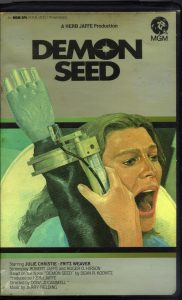

Promotional Material:




Miscellaneous:
Demon Seed was given a shout-out on the HBO series The Deuce. (Contains adult language.)
And here’s a great episode of The Projection Booth podcast all about Demon Seed.
https://radiopublic.com/the-projection-booth-podcast-WYBj2k/ep/s1!54d4d
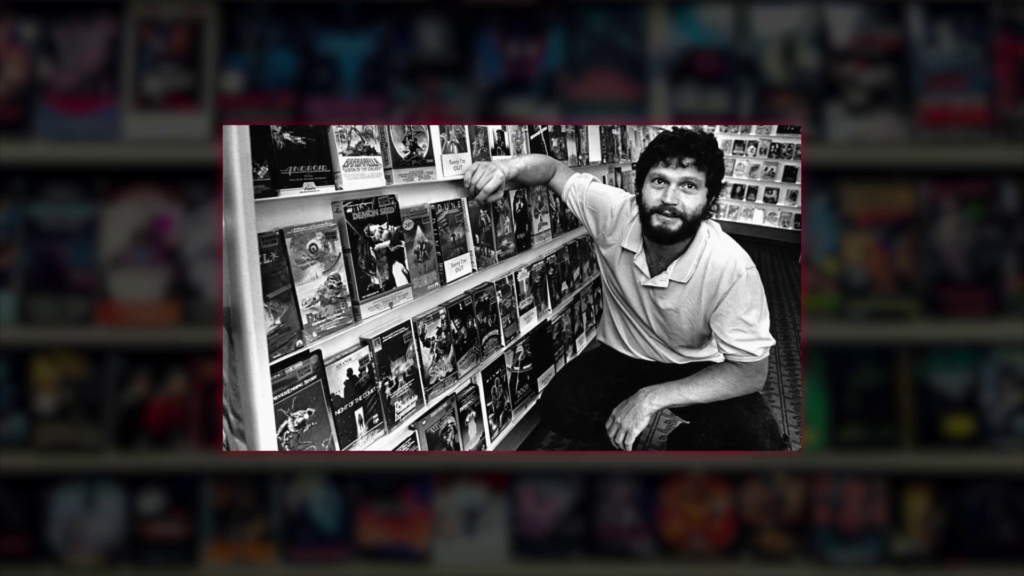
Related items:

Last updated on July 23rd, 2018
